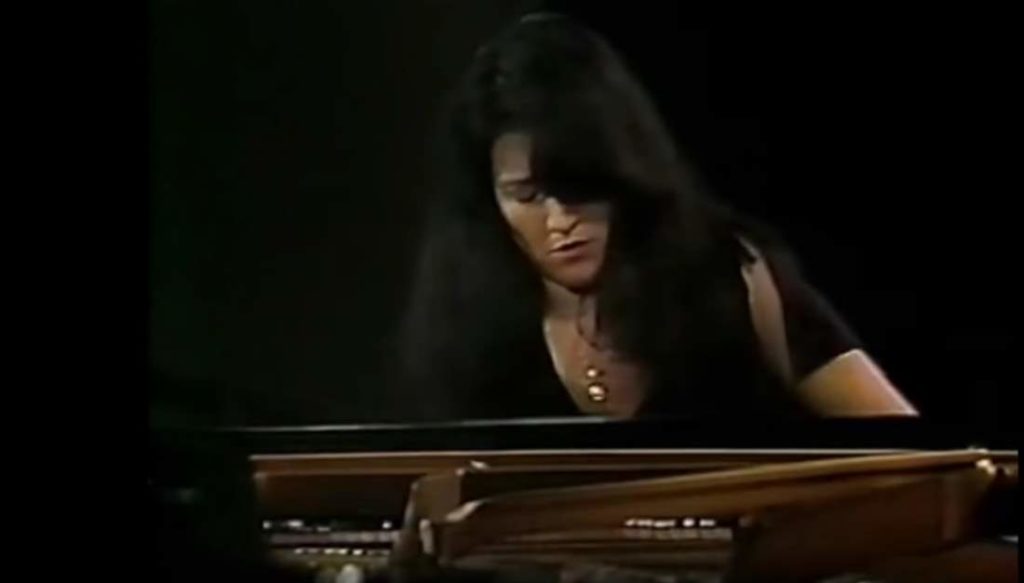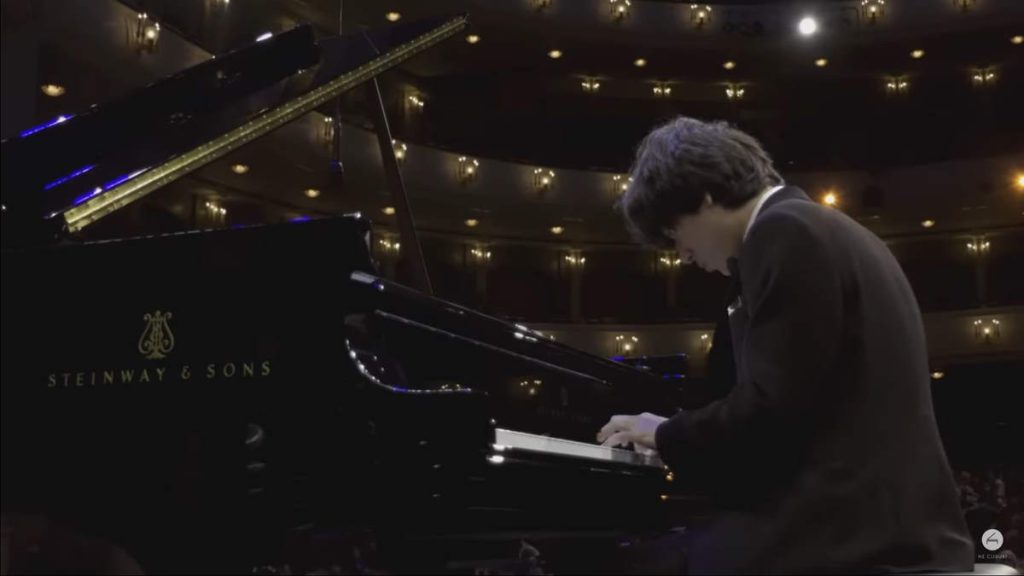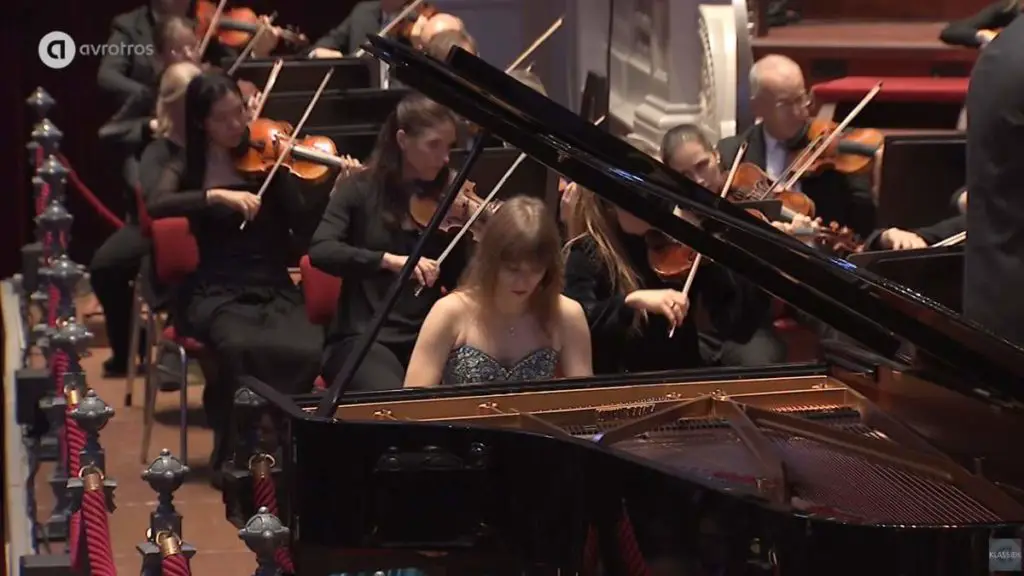Accompanied by the Staatskapelle Dresden, the Chinese pianist Yuja Wang performs Sergei Rachmaninoff’s Piano Concerto No. 3 in D minor, Op. 30. Conductor: Myung-Whun Chung. This performance was recorded on September 8, 2019, at the Palace Hall (Sala Palatului), Bucharest, Romania, during the George Enescu Festival.
Sergei Rachmaninoff’s Piano Concerto No. 3
Sergei Rachmaninoff’s Piano Concerto No. 3 is often hailed as one of the most complex and technically demanding concertos in the classical piano repertoire. Composed in 1909, the concerto was intended for Rachmaninoff’s first tour of the United States. It has since become a touchstone for pianists seeking to demonstrate both their technical mastery and emotional depth. The piece was written during a period of artistic renewal for Rachmaninoff, who had suffered a serious bout of depression following the poor reception of his Symphony No. 1. After a course of therapy and a return to composing, Rachmaninoff felt ready to take on the ambitious project of a new piano concerto.
From its premiere, the concerto was met with a range of reactions. For some, its technical demands were seen as insurmountable; for others, the piece was a pinnacle of the romantic piano concerto form. The length of the composition is also noteworthy. It spans approximately 40 minutes in performance, offering an expansive canvas upon which Rachmaninoff painted a wide range of human emotions.
One of the most striking aspects of the concerto is its deep emotional complexity. This isn’t a piece that can be easily pigeonholed as merely a showcase for virtuosic pyrotechnics. Instead, it delves into a profound emotional landscape, traversing states of yearning, despair, and ultimate triumph. Its melodies are long and sinuous, often developing in unexpected ways that take the listener on an emotional journey.
The orchestration, too, is lush and intricate, designed to both support and challenge the soloist. Rachmaninoff employs the full range of the orchestra to create textures that are sometimes delicate, and sometimes overwhelmingly powerful. Unlike some composers who treat the orchestra as a mere backdrop for the soloist, Rachmaninoff integrates the orchestra fully into the emotional narrative of the piece.
However, it’s important to note that while the concerto is complex and demanding, it isn’t merely difficult for the sake of being difficult. The technical challenges serve the musical and emotional aims of the piece, requiring the pianist to possess not just agility and strength, but also a deep understanding of the work’s emotional terrain.
In the years since its composition, the concerto has been embraced by both audiences and musicians alike. It has become a favorite choice for competitions and recordings, and it holds a secure place in the canon of classical music. Still, it is not a piece for the faint-hearted. Its length and technical demands require a level of stamina and interpretative insight that only the most skilled and committed pianists can deliver. Yet for those willing to take on its challenges, Rachmaninoff’s Piano Concerto No. 3 offers a richly rewarding musical experience that plumbs the depths of human emotion and virtuosic expression.
Movements
1. Allegro ma non tanto
The first movement of Sergei Rachmaninoff’s Piano Concerto No. 3 is a monumental undertaking in its own right and serves as a formidable gateway into the rest of the concerto. This movement is marked “Allegro ma non tanto,” which means “Fast, but not too much so,” signaling to the performer and the listener alike that while the tempo should be brisk, it shouldn’t rush past the emotional content.
The movement starts with a quiet but emotionally charged melody, which the piano introduces almost immediately. This theme serves as the backbone of the entire movement, coming back in various forms and permutations throughout. It is a melody full of longing and emotional intensity, and the way it’s treated sets the stage for the rest of the concerto. Rachmaninoff takes this initial theme and subjects it to a range of treatments: sometimes tender, sometimes grandiose, and at other times, intricately ornamental. The pianist must not only contend with the technical aspects of these variations but also convey the shifting emotional nuances they bring.
The orchestra plays a more than supporting role in this movement; it becomes a co-soloist of sorts. Rachmaninoff uses the orchestral palette to deepen and contrast the emotional states presented by the piano. There are sections where the orchestra takes over the thematic material entirely, allowing the piano to rest or offer embellishments. At other times, the piano and orchestra engage in a dialogue, echoing and responding to each other in a manner that’s almost conversational. This interaction between piano and orchestra amplifies the overall complexity of the movement, demanding a high level of ensemble skill.
But it’s not all lyricism and dialogue; there are also moments of sheer virtuosic display. Passages filled with rapid finger work, complex rhythms, and extensive use of the keyboard’s full range serve as a technical gauntlet that the pianist must navigate. These aren’t empty displays of skill; each of these moments serves a musical purpose, often heightening the emotional intensity or offering a contrast to the lyrical sections.
Despite its complexity and the technical demands it places on the performer, the first movement is often described as more introspective compared to what follows in the rest of the concerto. It serves as both an emotional and thematic foundation, introducing key musical ideas that will be explored and developed in the subsequent movements.
2. Intermezzo: Adagio
The second movement of Sergei Rachmaninoff’s Piano Concerto No. 3, marked “Intermezzo: Adagio,” serves as a contrasting interlude between the tumultuous first and third movements. Often described as more lyrical and contemplative, this movement provides both the pianist and the listener a moment of respite, but it is by no means a simple or straightforward piece. While it is generally slower in tempo and may seem less outwardly virtuosic compared to the surrounding movements, it presents its own set of interpretive challenges.
One of the primary characteristics of this movement is its introspective nature. The themes are more subdued and the emotional palette is broader, but more restrained, offering the opportunity for deeper introspection. This presents a unique challenge to the performer: the technical demands may be somewhat lessened compared to the first and third movements, but the need for emotional nuance and subtlety is heightened.
Much like the first movement, the orchestra is not merely an accompaniment but an integral part of the musical storytelling. Rachmaninoff employs delicate orchestration to paint an intricate emotional landscape. At times, the orchestra takes on a pastoral role, creating a backdrop of serenity that allows the piano’s melodic lines to shine. At other moments, it engages directly with the piano in an expressive dialogue, enriching the musical texture and emotional depth of the movement.
Musically, the movement employs some of the thematic material introduced in the first movement but treats it in a different light. Themes are recontextualized, explored through different harmonies, and elaborated with new ornamental details. These visitations offer a sense of cohesion to the concerto as a whole, linking the movements together in a way that adds depth and complexity to the overarching narrative.
What makes the second movement particularly interesting is how it acts as a pivot point in the concerto. It’s a space for reflection and a breath of air before plunging into the intense complexities of the final movement. It’s not just a pause; it’s a moment for the pianist and listener alike to recalibrate emotionally and musically. The performer has to convey this transitional quality effectively to capture the movement’s essence and its function within the concerto.
3. Finale: Alla breve
The finale of Sergei Rachmaninoff’s Piano Concerto No. 3
, marked “Finale: Alla breve,” is a dazzling tour de force that brings the concerto to its virtuosic and emotional climax. The movement serves as the culmination of all the themes, techniques, and emotional journeys introduced in the preceding movements. It is here that the pianist must muster all their technical prowess and emotional depth to deliver a satisfying conclusion to this monumental work.
From the outset, the movement exudes a sense of urgency and forward momentum. The tempo indication “Alla breve” essentially means “in cut time,” suggesting a quicker pace, and Rachmaninoff certainly lives up to that expectation. The thematic material is introduced quickly, and the movement plunges into a whirlwind of complex rhythms, intricate fingerwork, and emotionally charged exchanges between the soloist and the orchestra.
One of the highlights of this movement is the frequent return to and transformation of earlier themes, weaving them into a tapestry that ties the entire concerto together. Themes from the first and even the second movement are revisited but metamorphosed, often appearing in a more intense or elaborate form. This sense of thematic unity provides a feeling of culmination as if the entire concerto has been building up to this final burst of energy and expression.
The interaction between the piano and orchestra reaches a fever pitch in this movement. Rapid, virtuosic passages in the piano are often answered by robust, full-bodied responses from the orchestra. There are also moments where the piano and orchestra seem to be chasing each other, creating a thrilling sense of tension and release. This requires impeccable timing and a deep sense of partnership between the soloist and the conductor to execute successfully.
Technically, the third movement is a crucible of challenges for the pianist. It demands extreme dexterity, stamina, and precision to navigate its rapid passages, intricate rhythms, and extensive use of the full range of the keyboard. Yet, as with the rest of the concerto, these technical demands are not mere showmanship; they serve the greater musical and emotional narrative. The virtuosic elements must be integrated seamlessly into the flow of the music, each serving a specific expressive purpose.
Emotionally, this movement is often described as triumphant, bringing to a close the wide-ranging emotional journey that the concerto takes the listener on. After navigating through the lyrical introspection of the second movement and the varied emotional terrains of the first, the third movement arrives as a kind of catharsis, channeling all the built-up tension into a final, exhilarating release.
In summary, the third movement of Rachmaninoff’s Piano Concerto No. 3 is a brilliant finale that demands the utmost from the performer in terms of both technical skill and emotional investment. It’s a movement where all the threads of the concerto come together in a grand tapestry of sound, emotion, and virtuosity. Successfully executing this movement requires not only staggering technical ability but also an insightful understanding of its place within the larger framework of the concerto, making it one of the most challenging and rewarding pieces in the classical piano repertoire.
Sources
- Piano Concerto No. 3 (Rachmaninoff) on Wikipedia



